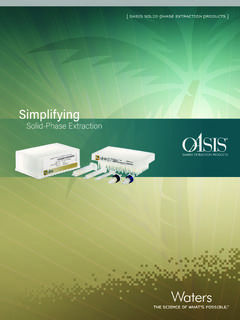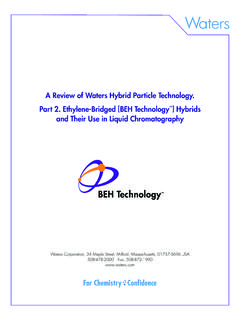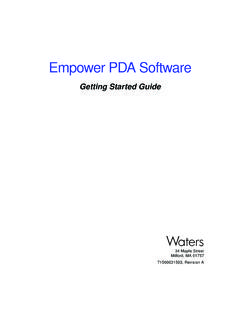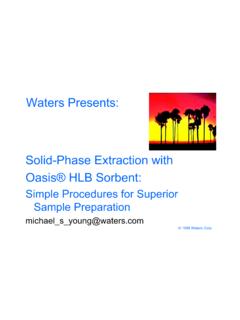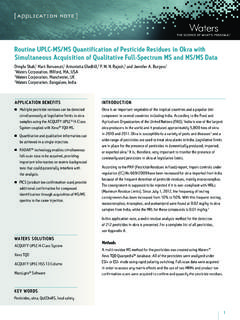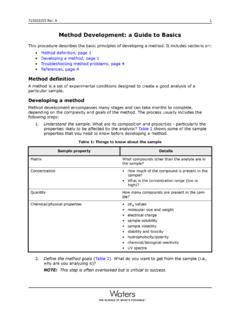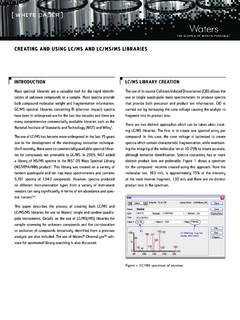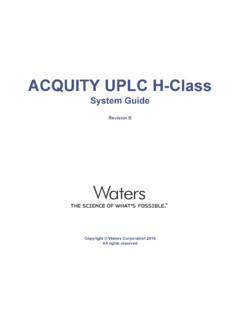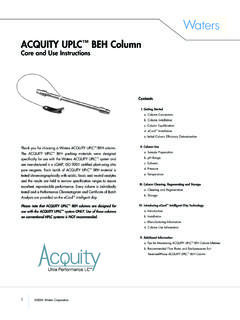Transcription of [Care and Use Man Ual ]
1 [ care and Use ManUal ]XBridge Columns1 Thank you for choosing a Waters XBridge column. The XBridge packing materials were designed to provide excellent peak shape, high efficiency, and excellent stability for acidic and basic mobile phases. The XBridge packing materials are manufactured in a cGMP, ISO 9001:2000 certi-fied plant using ultra pure reagents. Each batch of XBridge material is tested chromatographically with acidic, basic and neutral analytes and the results are held to narrow specification ranges to assure excellent, reproducible performance. Every column is individually tested and a Performance Test Chromatogram is provided with each column along with the certificate of Acceptance.
2 ContentsI. GettInG started a. Column Installation b. Column Equilibration c. Initial Column Efficiency DeterminationII. Column use a. Guard Columns b. Sample Preparation c. Operating pH Limits d. Solvents e. Pressure f. TemperatureIII. sCalInG up/down IsoCratIC methodsIV. troubleshootInGV. Column CleanInG, reGeneratIon and storaGe a. Cleaning and Regeneration b. StorageVI. ConneCtInG the Column to the hplC a. Column Connectors and System Tubing Considerations b. Measuring System Bandspreading Volume and System Variance c. Measuring Gradient Delay Volume (or Dwell Volume)VII. addItIonal InformatIon a.
3 Use of Narrow-Bore ( mm Columns) b. Impact of Bandspreading Volume on mm Column Performance c. Non-Optimized vs. Optimized LC/MS/MS System: System Modification Recommendations d. Waters Small Particle Size ( m) Columns Fast Chromatography e. Getting Started with XBridge HILIC Columns f. Getting Started with XBridge Amide ColumnsXbrIdGe Columns [Care and Use ManUal ]XBridge Columns2I. GettInG startedEach XBridge column comes with a certificate of analysis and a Perfor-mance Test Chromatogram. The certificate of analysis , lo c ated on t he te c hnic al information CD, is specific to each batch of packing material contained in the XBridge column and includes the batch number, analysis of unbonded particles, analysis of bonded particles, and chromatographic results and conditions.
4 The Performance Test Chromatogram is specific to each individual column and contains the information: batch number, column serial number, USP plate count, USP tailing factor, retention factor, and chromatographic conditions. This data data should be stored for future reference. a. Column InstallationNote: The flow rates given in the procedure below are for a typical 5 m pack-ing in a mm column. Scale the flow rate up or down accordingly based upon the column , length, particle size and backpressure of the XBridge column being installed. See Scaling Up/Down Isocratic Separations section for calculating flow rates when changing column and/or length.
5 See Connecting the Column to the HPLC for a more detailed discussion on HPLC connections1. Purge the pumping system of any buffer-containing mobile phases and connect the inlet end of the column to the injector outlet. An arrow on the column identification label indicates the correct direction of solvent Flush column with 100% organic mobile phase (methanol or ace-tonitrile) by setting the pump flow rate to mL/min. and increase the flow rate to 1 mL/min over 5 When the mobile phase is flowing freely from the column outlet, stop the flow and attach the column outlet to the detector.
6 This prevents entry of air into the detection system and gives more rapid baseline Gradually increase the flow rate as described in step Once a steady backpressure and baseline have been achieved, pro-ceed to the next section. Note: If mobile phase additives are present in low concentrations ( , ion-pairing reagents), 100 to 200 column volumes may be required for complete equilibration. In addition, mobile phases that contain formate ( , ammonium formate, formic acid, etc.) may also require longer initial column equilibration Column Equilibration XBridge columns are shipped in 100% acetonitrile.
7 It is important to ensure mobile phase compatibility before changing to a different mobile phase sys-tem. Equilibrate the column with a minimum of 10 column volumes of the mobile phase to be used (refer to Table 1 for a listing of empty column volumes).To avoid precipitating out mobile phase buffers on your column or in your system, flush the column with five column volumes of a water/organic solvent mixture, using the same or lower solvent content as in the desired buffered mobile phase. (For example, flush the column and HPLC system with 60% methanol in water prior to introducing 60% methanol/40% buffer mobile phase).
8 For XBridge HILIC columns, flush with 50 column volumes of 50:50 acetonitrile:water with 10 mM final buffer concentration. For XBridge HILIC Amide columns, flush with 50 column volumes of 60:40 acetonitrile:aqueous. Prior to the first injection, equilibrate with 20 col-umn volumes of initial mobile phase conditions (refer to Table 1 for a list of column volumes). See Getting Started with XBridge HILIC Columns or Getting Started with XBridge HILIC Amide Columns for additional information. c. Initial Column Efficiency Determination 1. Perform an efficiency test on the column before using it in the desired application.
9 Waters recommends using a suitable solute mixture, as found in the Performance Test Chromatogram, to analyze the column upon receipt. 2. Determine the number of theoretical plates (N) and use this value for periodic comparisons. 3. Repeat the test at predetermined intervals to track column perfor-mance over time. Slight variations may be obtained on two differ-ent HPLC systems due to the quality of the connections, operating environment, system electronics, reagent quality, column condition and operator technique. [ care and Use ManUal ]XBridge Columns3 Table 1: Empty Column Volumes in mL (multiply by 10 for flush solvent volumes)Column internal diameter (mm)Column Length (mm) 30 2070176490II.
10 Column useTo ensure the continued high performance of XBridge columns, follow these guidelines:a. Guard Columns Use a Waters guard column of matching chemistry and particle size between the injector and main column. It is important to use a high-performance matching guard column to protect the main column while not compromis-ing or changing the analytical resolution. Guard columns need to be replaced at regular intervals as determined by sample contamination. When system backpressure steadily increases above a set pressure limit, it is usually an indication that the guard column should be replaced. A sudden appearance of split peaks is also indicative of a need to replace the guard Sample Preparation 1.
